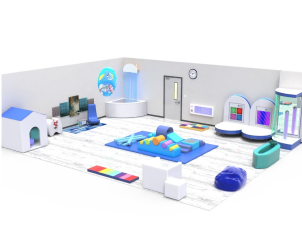Pull out the paint, crayons, paper and scraps. It's time to give your budding artist an outlet. Don't have a budding artist? Well, everyone has a bit of an artist in them. Art provides a terrific sensory outlet for children and adults of all abilities and brings the body, brain, and spirit together in one integrated-sensory-stimulating experience. You don't have to be an art teacher to provide a great art experience, either. Art can take the form of creative expression, cooking or music. Lets take a look at some easy sensory-motor art ideas. Remember to provide a clutter-free, quiet environment for your art time. You may want to add in some classical or soft music and aromatherapy to go with it. Make sure your area is well lit, but not overly bright. Art should engage the body and mind but calm the senses.
1) Dough, Putty and Clay: These are by far my favorite for heavy handwork. Heavy handwork is super for warming up the hands and de-stressing. It's great before writing skills are needed or to work on fine motor coordination. Dough is softest and can be purchased or made when baking. Putty can be purchased in multiple resistances and clay is best for your serious builders. All three provide a great work out to the hands, fingers, forearms, and shoulders. Use imagination or guide your kids to create items, pots, bowls, and scenes on paper.
2) Sand Creations: Grab a bowl, tub or sand table and play sand. Then throw in some forks, spoons, tools and cups. Kids can play with sand (and water) for hours. You can use glue and create sand pictures on paper by sprinkling the sand onto the glue. There are many sands that are mess-free such as Delta Sand⢠or modeling sands. There are also sands that hold water.
3) Painting: Painting provides a gentle upper body workout. Kids are great at using their thumbs today, but not so great with large motor muscles. Painting is crucial for developing the larger up/down skills useful in heavy work. You need an easel, paper, brushes, paint, and some old shirts or smocks. Now let Picasso do his magic!
4) Metal Art (Ages 9+): Grab some metal sheets (at any art store) or heavy-duty foil. Kids will need a hammer and some nails. Provide a thick piece of cardboard under their workspace. Now have them hammer out their name, shapes or design. Use with kids 9 and over and under supervision. A sensory integration, eye-coordination and target skill.
5) Puppet Making: Let your kids express themselves with puppet making. Use brown lunch bags or old socks as well as glue and any objects you can find. They can make faces and then use the puppets to create shows, talk, express themselves and emote.
6) Finger Paint: Finger painting is a must for sensory seekers, avoiders (they need this!) and over responders (it's soothing). Fingers need to get messy to work well. Get some finger painting paper, a tray and paints. Put a blog on each sheet and let them go. They may be reticent at first, but then watch out. You will find your sensory seekers right away and your sensory avoiders as well. Your sensory over responders will lavish in the experience.
7) Card Making: Email may be in, but making cards is therapeutic! Kids can use cardboard, stamps, ink, sponges, stickers and glue on letters. Give them some direction, like a birthday card, holiday card or note to Grandma. Card Making uses their creativity but also encourages fine motor skills as well.
8) Rock Art: Create a pet rock, or rock design. Just collect smooth surfaces rocks, the bigger the better. Have paint ready and let them design your walkway. They can make a memorial, a meditation spot or decorate a flower garden.
9) Melted Crayons (Ages 9+): Got old crayons? Grab a canvas from your local store and let your kids decorate with a sharpie or permanent marker. Attach the crayons to the top with a glue gun. Place the canvas on an angle with a newspaper at the bottom. Then grab an old hairdryer and melt the crayons until they drip down the canvas. Kids can do this with supervision. Allow the crayons to melt down onto the canvas. It's a visual experience gone wild!
10) Wire Sculptures: Purchase a soft foam brick from your local art store and some bendable wire. Put one end of the wire in the foam and then let the kids place beads along the wire. Have them bend the wire to create any form they like and place the other end into the foam block when finished bending. This creates a beautiful wire sculpture and encourages the development of intrinsic hand muscles.
Check out our sensory tools for kids with autism.
Don't limit yourself to what you see here. Take a walk around your local art store or visit Pinterest. You can adapt activities for your sensory avoiders, seekers and over responders. And, remember, practice makes…..art fun!



















Comments